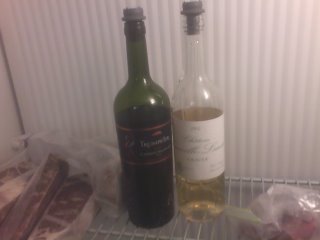
Ok, my estudiantes, this week let's get together and do a Chemistry experiment. We are going to freeze two opened bottles of wine and see if this is a "reasonable" way of saving wine over a long period of time, one which exceeds normal expectation. We know that oxygen is the enemy of opened wines, and that oxidation gives wine that vinegar taint over time. When we freeze wine, having first minimized the amount of air in the freezing vessel, we minimize the long term contact with oxygen in two ways: the vacuum itself minimizes some of it, and the solid nature of the ice keeps oxygen from permeating the wine. What we hope will happen is that the wine will, upon thawing, approximate a smaller diminution of flavor than if had been ruined by leaving in a liquid state. Join me in taking a partially consumed Red and White and let's freeze it for the next two weeks. Because of the properties of freezing, be sure to Vaccu Seal the bottle, or consider placing the wine in a plastic bag that has had most of the air removed. Leave some space for expansion though.
One thing we can expect is that in the process of freezing, the water in the wine will freeze prior to the alcohol. This, I'm told will allow some of the solids in the wine to "precipitate out", forming small crystal in the thawed wine. It is my understanding that these are tartaric acid crystals, and are tasteless. This will be the only flaw to the texture, but I'm told that the finished product can actually improve in taste because of the decrease in acidity! Well, we shall see! I take no responsibility for any broken bottles. Please Vaccu Seal the wine to preclude that!
When we are ready to thaw the wine...I'll have some techniques for that too, which even include the microwave! I think you will be amazed at the outcome.
The last thing that is important is to make notes about how the wine tastes before the freezing so we can compare. I have chosen a Argentine Cabernet Sauvignon, and a Bordeaux White, which is Semillon and Sauvignon Blanc. The latter is young and acidic, so we shall see if we lose too much character by losing the acid. The Cab is a typical South American with a light style and nice dark fruits. Very light tannins make this a candidate for storing in an unconventional way, because tannins would help to keep it from spoiling too quickly if left at room temperature.
See you in two weeks!

No comments:
Post a Comment